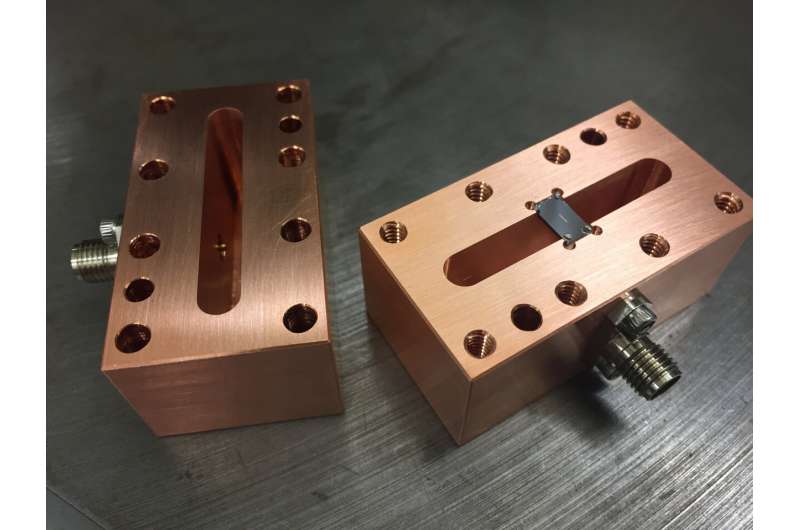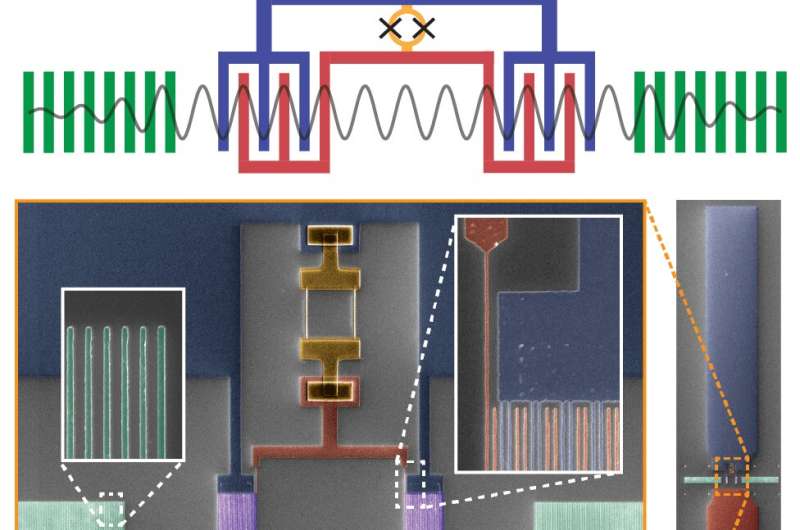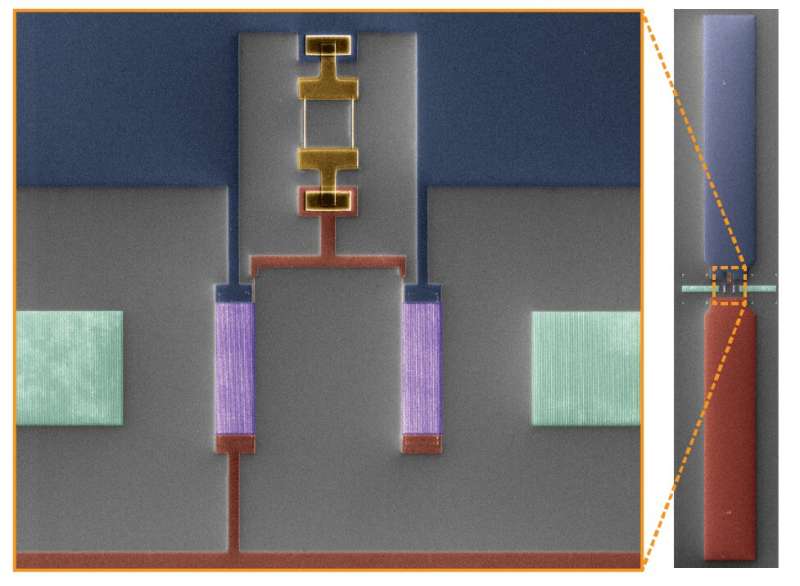July 11, 2019 feature
Coupling qubits to sound in a multimode cavity

In a recent study, researchers at the University of Colorado have resolved phonon Fock states in the spectrum of a superconducting qubit coupled to a multimode acoustic cavity. Fock states (or number states) are quantum states with a clearly defined number of particles. These states play a crucial part in the second quantization formulation of quantum mechanics.
In their paper, published in Physical Review X, the researchers outline how they coupled a qubit to surface acoustic waves and successfully engineered a sharp frequency dependence in the qubit-phonon interaction. The interference resulting from this process generated a high-contrast frequency structure in the qubit-phonon interaction.
"Inspired by the successful use of qubits to control quantum states of light, we wanted to explore what we can achieve by coupling qubits to sound," Lucas Sletten, one of the researchers who carried out the study, told Phys.org. "We asked ourselves: Is it possible to resolve that sound in a solid is, in fact, quantized? Can sound be used to store and process quantum information? Can these particle-like quanta of sound, termed phonons, be counted without destroying them? If so, could you play this trick with more than one mode at a time? And more generally, what is possible with sound that can't be done with light?"
Sletten and his colleagues used a device made up of a superconducting qubit that interacts strongly with phonons trapped in an acoustic cavity. The device was placed inside a microwave resonator that serves as a sensitive probe of the qubit. This allowed the researchers to measure and control the qubit, while observing its interaction with phonons.

"The phonons live in an acoustic resonator that functions like a musical instrument, but at frequencies 20 octaves above the highest note on a piano," Sletten said. "Just like an instrument, there are different notes, or modes, that can live within our resonator. The electrical analog of such a multi-mode resonator would be many meters long and a nightmare to implement on chip."
A mode within the resonator corresponds to an integer number of ripples fitting exactly into the box, or cavity, that confines the sound waves. To sense the motion of the trapped phonons, Sletten and his colleagues connected the qubit to the acoustic resonator using a transducer that transforms motion into electrical current. When sound is excited in their resonator, therefore, the qubit sees a current that alters its energy.
"We engineered a system sensitive enough that even the quietest sound allowable by quantum mechanics, a particle-like single phonon, shifts our qubit's energy enough for us to notice," Sletten said. "Moreover, this detection does not destroy the phonons we measure. We can count phonons not only for one mode of the cavity but for several, demonstrating we can take full advantage of our multi-mode cavity."
The findings gathered by Sletten and his colleagues show that superconducting qubits can interact with sound waves strongly enough to reveal the quantum nature of sound, without a direct exchange of energy taking place. By attaining sensitivities high enough to break a sound wave into quantized parts, the researchers have moved one step closer to achieving excellent quantum control of acoustic systems.

"Another insight from our work is that the slowness of sound can be a valuable resource in engineering quantum systems," Sletten said. "The long time it takes for a phonon to bounce back and forth between the mirrors is what allows the cavity to support multiple modes. Additionally, we leverage a long delay inserted in the middle of our transducer to precisely control how the qubit interacts with each mode, a crucial ability in counting phonons in a multi-mode cavity."
In the future, the research conducted by Sletten and his colleagues could pave the way towards the development of effective techniques to control acoustic quantum states. Meanwhile, the researchers plan to continue exploring the use of phonons in quantum science.
For instance, they would like to investigate whether it is possible to entangle several different phonon modes ('notes') based on their shared interaction with a qubit. If confirmed experimentally, this would prove the huge potential of phonons for quantum information processing applications.
"Acoustic systems are also a promising interface between different quantum platforms, such as superconducting qubits, quantum dots, and optical photons, and may also prove powerful tools for investigating the types of surface physics that may be limiting some cutting edge quantum technologies," Sletten added.
More information: L. R. Sletten et al. Resolving Phonon Fock States in a Multimode Cavity with a Double-Slit Qubit, Physical Review X (2019). DOI: 10.1103/PhysRevX.9.021056
Journal information: Physical Review X
© 2019 Science X Network



















